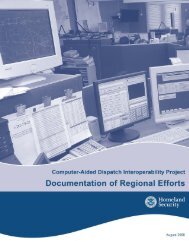Video Quality in Public Safety (VQiPS) Workshop Report - SafeCom
Video Quality in Public Safety (VQiPS) Workshop Report - SafeCom
Video Quality in Public Safety (VQiPS) Workshop Report - SafeCom
Create successful ePaper yourself
Turn your PDF publications into a flip-book with our unique Google optimized e-Paper software.
VII. Next Steps<br />
20<br />
<strong>Video</strong> <strong>Quality</strong> <strong>in</strong> <strong>Public</strong> <strong>Safety</strong><br />
July 26‐27, 2012 <strong>Workshop</strong> <strong>Report</strong><br />
a. This technology reduces false alarms by help<strong>in</strong>g to verify that all alarm<br />
transmissions are valid before the alarm is set off.<br />
8. Device Authentication<br />
a. Device authentication m<strong>in</strong>imizes the possibility of exploits of cameras on<br />
public networks.<br />
9. <strong>Video</strong> Content Analysis<br />
a. <strong>Video</strong> content analysis can reduce <strong>in</strong>cident review time by at least 50<br />
percent and allow agencies to set specific object criteria.<br />
b. Technology also allows agencies to look at 24 hours of footage <strong>in</strong> as little<br />
as 15 m<strong>in</strong>utes.<br />
10. Edge Devices<br />
a. Edge devices provide users with the ability to transact with other people <strong>in</strong><br />
a self-conta<strong>in</strong>ed area which <strong>in</strong>creases their protection zone.<br />
In 2009, when <strong>VQiPS</strong> was started by OIC and PSCR, the <strong>VQiPS</strong> Leadership set out to<br />
accomplish two Phase 1 goals: educate the end users about video systems and help end users<br />
def<strong>in</strong>e their own requirements. Now <strong>in</strong> 2012, the <strong>VQiPS</strong> Leadership Team reports that they have<br />
accomplished those goals with the development of the <strong>Video</strong> <strong>Quality</strong> User Guide and the<br />
Recommendations Tool for <strong>Video</strong> Requirements. The Leadership Team recommends that<br />
<strong>VQiPS</strong> Phase 2 focus on video over broadband efforts given the pass<strong>in</strong>g of recent legislation and<br />
the impend<strong>in</strong>g creation of a nationwide public safety broadband network. The Work<strong>in</strong>g Group<br />
will start to work on video projects that will <strong>in</strong>form public safety agencies about their video over<br />
broadband needs, such as bandwidth capacity and standards.<br />
The <strong>VQiPS</strong> Work<strong>in</strong>g Group left the <strong>Workshop</strong> hav<strong>in</strong>g made the commitment to work on the<br />
follow<strong>in</strong>g activities:<br />
� Connect with <strong>VQiPS</strong> Team Leads<br />
� Engage with broadband <strong>in</strong>itiatives<br />
� Provide feedback on <strong>Video</strong> <strong>Quality</strong> <strong>in</strong> <strong>Public</strong> <strong>Safety</strong> Standards Handbook draft<br />
� Test Web Tool and provide feedback via the new Feedback button; provide success<br />
stories on us<strong>in</strong>g the Web Tool to <strong>VQiPS</strong>_Work<strong>in</strong>g_Group@sra.com<br />
The <strong>VQiPS</strong> Leadership Team also shared its Deliverable Roadmap for the com<strong>in</strong>g year:




